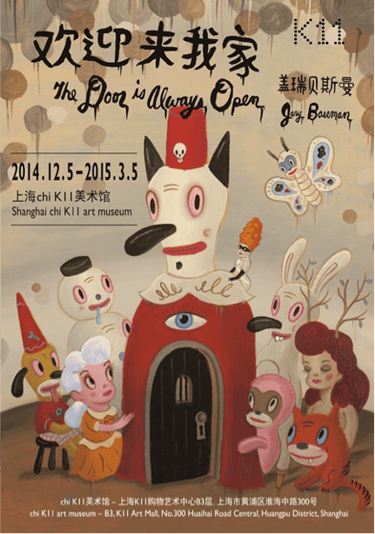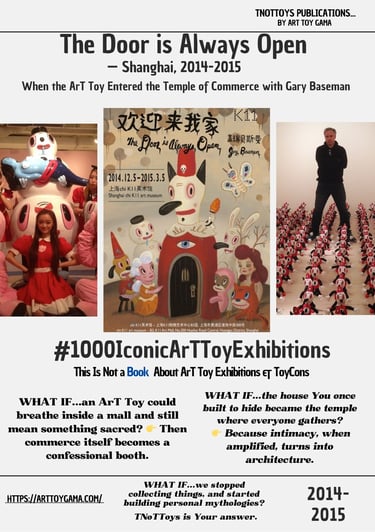We didn’t lose our inner child. We turned it into ArT Toys and More...with purpose.
🀄 The Door is Always Open — Shanghai, 2014–2015
When the ArT Toy Entered the Temple of Commerce with Gary Baseman. The Door is Always Open Exhibition in Shanghai, China 2014 #00023 — TNoTToys Publications
TNOTTOYS PUBLICATIONS1000 ICONIC ART TOY EXHIBITIONS
Sergio Pampliega Campo & Cristina A. del Chicca
🌀 This post is part of an ongoing research series from Art Toy Gama’s editorial division:
📚 This Is Not a Book About Art Toy Exhibitions & ToyCons
Context Matters
Shanghai, 2014.
In a city where emotion moves at the speed of capital, Gary Baseman brings his home to the chi K11 Art Museum — a museum built inside a luxury mall, a hybrid temple of art and consumption.
Here, the ArT Toy doesn’t infiltrate the system. It inhabits it.
The door opens — but not for You to enter.
It opens so that what was hidden can finally escape.
From Los Angeles to Taipei, the home had already evolved: from private confession to cultural dialogue.
Now, in Shanghai, it becomes a global altar, where intimacy and spectacle coexist.
From memory to market, from wound to wonder, from childlike gesture to cultural statement: the ArT Toy completes its transformation.
This is the final act of The Door is Always Open:
the house becomes a world.
The toy becomes architecture.
And the invitation becomes prophecy.
POSTER Reading: The House with a Heartbeat
A red figure dominates the scene: half house, half dog, all pulse.
Its torso holds a door…open, literal, alive.
Its face smiles, but the smile aches.
Around it orbit creatures of the Baseman pantheon:
Hot Cha Cha Cha, ChouChou, the Wild Girls, the butterfly with eyes.
They don’t pose; they witness.
Every eye in the composition looks inward, not outward…as if all devotion, all gravity, all memory now revolves around Toby transformed into a home.
This is not architecture.
It’s embodiment.
A church built by someone who worships the absurd.
The background is beige and dreamlike, washed in nostalgia.
The air hums with calm chaos.
You can feel the warmth, but You also feel watched.
The door in Toby’s chest is both literal and metaphoric; the threshold where the viewer and the viewed trade places.
Baseman no longer asks You to peek.
He asks You to enter and stay.
🔑 Symbolic Core
In Los Angeles, we stared through a keyhole.
In Taipei, we entered the dream.
In Shanghai, we live inside the house.
Toby is no longer the guest or the guide.
He is the house — the host-body of the myth itself.
The domestic turns monumental; the intimate turns collective.
Every character around him behaves like an emotional satellite:
the butterfly of transformation, the clown of confusion, the Wild Girls who protect and provoke.
Each one is a virtue disguised as vice — innocence dressed as chaos.
The door on Toby’s chest is the final stage of Baseman’s narrative:
the heart as threshold.
The home as body.
The body as confession.
The ArT Toy doesn’t look at You anymore.
It breathes with You.
✍️ Typography and Language as Emotional Commerce
The text is bilingual — The Door is Always Open / 欢迎来我家 — and for the first time, it doesn’t translate.
It negotiates.
It creates a pact between two visual civilizations:
English trembling like confession, Chinese glowing like mantra.
Below, Baseman’s name appears again in characters — 盖瑞•贝斯曼 (Gài ruì bèi sī màn).
A phonetic echo, yes, but also a surrender.
When a name crosses alphabets, it ceases to belong only to its origin.
Baseman allows himself to be rewritten, absorbed, reborn.
The calligraphy drips, unstable, ceremonial, as if painted during a ritual, halfway between signature and spell.
Each stroke looks like it bleeds ink.
Each word feels like it’s breathing.
This is not typography.
This is transmutation.
Language here behaves exactly like an ArT Toy:
a hybrid object that holds emotion in physical form.
🎨 Color as Emotional Architecture
The palette returns to red; not as violence, but as pulse.
• Red: heartbeat, heat, door, memory.
• Black and white: contrast that cuts; shadow and revelation.
• Pastel beige: the dream turned daylight.
The red house is not decoration.
It’s the arterial center of the image: a body that contains both tenderness and trauma.
The surrounding colors hum quietly, as if painted with diluted nostalgia.
The palette behaves like breath: inhale (warmth), exhale (distance).
The POSTER feels alive.
🌀 Composition and Emotional Geometry
This is Not a layout. It’s choreography.
The figures move in invisible rhythm.
The central house anchors everything, yet every surrounding element pushes outward.
Expansion, invitation, exposure.
All eyes turn inward toward Toby’s chest, toward that open door.
The message is clear:
Home is no longer a refuge. It’s a portal.
You don’t enter art.
Art enters You.
🧸 What the Exhibition Showed: The Fusion of Worlds
At the chi K11 Art Museum — between boutiques and billboards — Baseman built a sanctuary.
From December 2014 to March 2015, visitors crossed from commerce into confession.
The Exhibition recreated his rooms once again: living room, kitchen, study, childhood bedroom.
But this time, the intimacy floated inside luxury glass.
Memory met consumerism and didn’t apologize.
Illustrations, paintings, Art Toys, installations, videos…all intertwined.
Objects were not displayed. They lived.
The ArT Toy wasn’t on a pedestal. It was on the table, in the chair, under the lamp.
The house had become the museum.
The museum had become a house.
💥 Why It Mattered: The Victory of the Hybrid
Shanghai marked the institutional consecration of the ArT Toy.
It wasn’t underground anymore. It was everywhere.
This Exhibition proved that vulnerability could exist even inside commercial walls; that Art could be emotional and expansive without losing its soul.
The ArT Toy ceased to be a “designer toy.”
It became cultural code.
A bridge between the emotional and the economic.
A pop-surrealist ritual for the age of consumer spirituality.
Baseman didn’t adapt to China; he infected it.
His mythology absorbed the local visual grammar, merging temple and toy, prayer and play.
The result?
The first global visual dialect of the Movement:
the absurd made sacred, the toy made monumental, the private made universal.
This was not marketing.
This was meaning.
🧠 Legacy & Mutation
In Shanghai, the ArT Toy completed its evolution.
From Los Angeles’ confession to Taipei’s translation: Shanghai became the transmission.
The house was now alive.
The Exhibition, immersive.
The mythology, universal.
Here, the ArT Toy learned to breathe inside capitalism and still remain pure emotion.
Baseman proved that Art could survive commerce; not by resisting it, but by haunting it.
The K11 space, half museum and half mall, became the perfect paradox:
art as luxury, luxury as emotion.
The absurd finally conquered the respectable.
The red Toby-house became the symbol of this new age:
A creature that invites You in, not to show comfort; but to show how intimacy survives exposure.
Behind every toy, there’s still a wound.
And behind every wound, a door.
Final Thought: ArT Toy Gama Perspective: Dis(Play) as Global Code
Baseman didn’t exhibit figures.
He exhibited thresholds.
He didn’t design characters.
He designed wounds You could walk through.
This POSTER for The Door is Always Open in Shanghai radiates a more theatrical, expansive, and narrative energy than its predecessors.
The central figure — a red dog-faced house with a door in its torso — acts as an emotional host, surrounded by fantastic creatures that amplify its tone of welcome, memory, and surrealism.
The use of both Chinese and English typography reinforces not only cultural openness but also the universal character of Baseman’s emotional architecture.
The Shanghai POSTER — and the entire Exhibition — is not a promotion.
It’s a ritual of access.
A Dis(Play) in its purest form: emotion performed through aesthetics.
The door here isn’t just open.
It’s breathing.
At Art Toy Gama we say:
The absurd becomes truth when repeated with devotion.
And in Shanghai, it happened.
The Toby that once was toy is now house, altar, museum, emotional map.
The ArT Toy doesn’t get displayed anymore.
It lives You.
🌀 Curatorial Reflection: The Trilogy as Emotional Cartography
Los Angeles — The Keyhole and the Wound.
The home as trauma. The POSTER as confession.
A whisper that became an emotional manifesto.
Taipei — The Dream and the Translation.
The home as ritual. The POSTER as bilingual prayer.
An emotional bridge between memory and myth.
Shanghai — The House and the World.
The home as architecture. The POSTER as prophecy.
An emotional system disguised as design.
Each chapter opens the same door wider, from private to collective, from silence to spectacle, from vulnerability to vision.
Each POSTER is not advertisement, but artifact.
Each exhibition is not display, but memory incarnate.
Together they form a single sentence:
The Door is Always Open… not to enter Art, but to remember Yourself through it.
Join The First and Only Art Toy Newsletter Society in the World here: https://emails.arttoygama.com/l/email-subscription
🔗 ENTER THE ART TOY GAMA STORE
#1000IconicArTToyExhibitions
We’re currently building an Upcoming Publication that explores and celebrates
the most iconic and influential Art Toy exhibitions around the world.
Each article in this series helps document, reflect, and invite the community
to take part in constructing this cultural archive — one exhibition at a time.
We’ve seen countless exhibitions since then: small and large, modest and monumental.
And we love them all.
No matter where they take place or the resources behind them,
every ArT Toy show adds something to the Movement.
Some will make history, others will make Memory. All of them matter.
This is not just documentation.
This is Dis(Play) in the making.
And You’re part of it.
Art Toy Gama Legacy
#ArTToyGamaLegacy
Art Toys. Paintings. Fine Art Prints. Not what You expect.
Real collectors don't follow trends—they redefine them
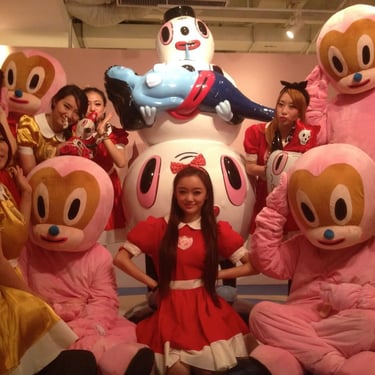
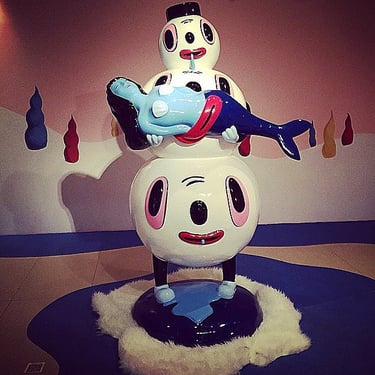
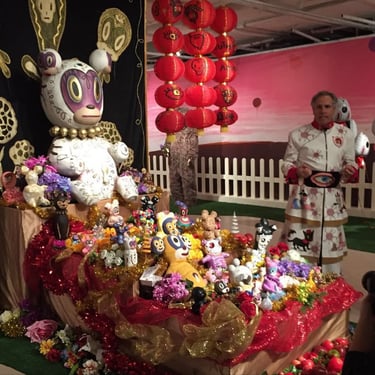
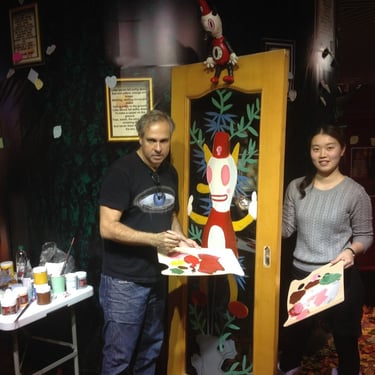
We didn’t lose our inner child. We turned it into Art.
You collecting, or just hoarding what the algorithm spoon-feeds you?
contact
© 2025. All rights reserved.


